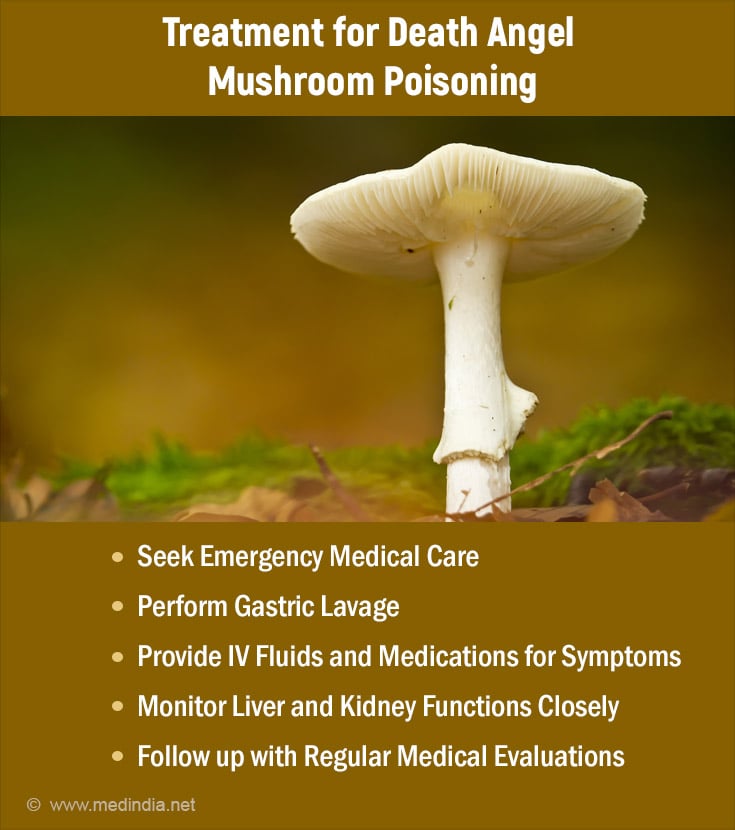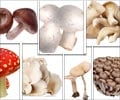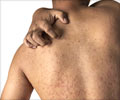- Western Destroying Angel Amanita ocreata - (https://www.inaturalist.org/taxa/67356-Amanita-ocreata)
- Amanita virosa - (https://plants.ces.ncsu.edu/plants/amanita-virosa/)
- Amanita bisporigera - (https://plants.ces.ncsu.edu/plants/amanita-bisporigera/)
About
The Death Angel Mushroom, known scientifically as Amanita ocreata, is a highly toxic fungus that poses significant health risks found primarily in the western United States(1✔ ✔Trusted Source
Western Destroying Angel Amanita ocreata
Go to source).
It belongs to the Amanitaceae family, which includes some of the most toxic fungi known. This mushroom is notorious for its severe toxicity and potential to cause fatal poisoning if ingested.
Did You Know?
The Death Angel mushroom's toxins can cause fatal liver failure if not treated promptly. #toxicology #deathangelmushroom #medindia
Death Angel Mushroom Identification
Identifying the Death Angel Mushroom correctly is crucial to avoid accidental poisoning. Here are its key features:
- Cap: The cap is white to off-white, smooth, and may have a slightly sticky surface when wet. It ranges from 5-10 cm (2-4 inches) in diameter and can be convex or flat with age. The cap lacks the prominent umbo seen in some other Amanita species.
- Gills: The gills are white, free from attachment to the stem, and closely spaced. They are not attached to the stem, which helps in distinguishing it from some other similar mushrooms.
- Stem: The stem is white, slender, and bulbous at the base. It can grow up to 15 cm (6 inches) tall and often features a membranous ring or skirt near the top. The stem is smooth and tapering towards the base.
- Spores: The spore print is white, which can be a useful identification feature but is not definitive on its own.
- Odor and Taste: The mushroom typically has a faint, not particularly distinctive odor and a mild taste, which can make it difficult to identify by smell or taste alone.
Symptoms of Death Angel Mushroom Poisoning
Symptoms of poisoning from Amanita ocreata may not appear immediately and can be severe.
1. Initial Symptoms (6-12 Hours After Ingestion):
- Early symptoms often include persistent nausea and vomiting.
- Severe cramping and pain in the abdominal area.
- Frequent, watery diarrhea.
2. Latent Period (12-48 Hours After Ingestion):
Symptoms may temporarily improve, giving a false sense of security as the toxins continue to affect the liver and kidneys.
3. Advanced Symptoms (48-72 Hours After Ingestion):
- Jaundice: Yellowing of the skin and eyes due to liver damage.
- Persistent and intense abdominal pain, often worsening.
- Confusion or Delirium due to liver failure.
- Unusual bleeding or bruising due to liver damage affecting clotting factors.
- Kidney Failure with Decreased urine output, swelling, and fatigue.
4. Critical Symptoms (72 Hours and Beyond):
- Potential for liver failure, which can be fatal if not treated promptly.
- Potential for complications involving other organs due to the systemic spread of toxins.
5. Long-Term Effects:
Permanent damage to liver function, which may lead to long-term health issues.
Prompt medical attention is crucial for anyone suspected of consuming Death Angel mushrooms to manage symptoms effectively and prevent serious complications.
Death Angel Mushroom Poisoning Treatment
Treating poisoning from the Death Angel mushroom (Amanita ocreata) requires immediate medical intervention due to the severity of the toxins involved.
The treatment approach is typically multi-faceted and involves several key steps:
1. Immediate Medical Attention
Seek emergency care as soon as possible if poisoning is suspected. Time is critical, and early treatment improves the chances of recovery.
2. Decontamination
Activated Charcoal: To absorb toxins and prevent further absorption into the bloodstream. Administered by healthcare professionals, typically within 1-2 hours of ingestion. The effectiveness diminishes over time, so prompt administration is crucial.
Gastric Lavage (Stomach Pumping): To remove unabsorbed toxins from the stomach. Involves inserting a tube into the stomach to flush out contents. This is usually considered if the patient presents within a few hours of ingestion.
3. Supportive Care
- Intravenous Fluids: To maintain hydration and support kidney function. Administered to combat dehydration and support vital functions.
- Medications: To manage symptoms and complications. Includes anti-nausea medications, pain relief, and medications to support liver function.
4. Specific Treatments
- N-acetylcysteine (NAC): To protect the liver and reduce damage. Administered intravenously, NAC is used to mitigate liver toxicity and is most effective when given early.
- Liver Support: To manage severe liver damage. May include medications to support liver function and monitoring of liver enzymes.
5. Advanced Interventions
- Liver Transplant: To replace a failing liver in cases of severe liver damage or failure. Considered when liver damage is irreversible and other treatments are not effective.
- Monitoring and Care: Continuous monitoring of liver and kidney function. Includes regular blood tests to assess the extent of damage and adjust treatment as needed.
6. Long-Term Management
- Follow-Up Care: To monitor recovery and manage any long-term effects. Includes regular check-ups, liver function tests, and possibly counseling for psychological impacts of severe illness.
- Lifestyle Adjustments: To support liver health and overall recovery. May involve dietary changes, avoiding alcohol and certain medications, and regular medical evaluations.
Treatment for Death Angel mushroom poisoning involves immediate medical attention, decontamination methods such as activated charcoal or gastric lavage, supportive care including intravenous fluids and medications, and potentially advanced interventions like liver transplantation in severe cases. Early and comprehensive treatment is essential to manage the severe effects of the toxins and improve the chances of recovery.

Differences Between Amanita ocreata, Amanita virosa, and Amanita bisporigera Species
Amanita ocreata, Amanita virosa, and Amanita bisporigera are all highly toxic mushrooms in the Amanita genus, commonly known as "Death Angels" or "Destroying Angels."Amanita virosa is larger than Amanita bisporigera and Amanita bisporigera is a smaller species, while Amanita virosa is more robust but both are equally poisonous.
Despite their similarities, they differ in geographic distribution, size, and specific morphological features.
Amanita ocreata (Western North America):
- Geographic Distribution: Found primarily in the western United States, particularly in California and the Pacific Northwest.
- Appearance: Features a white to off-white cap that is smooth and can be slightly sticky when wet. The gills are white and free from the stem. The stem is white, slender with a bulbous base, and often has a membranous ring near the top. The spore print is white.
- Season: Fruiting occurs from spring to early summer.
- Toxins: Contains amatoxins, particularly alpha-amanitin, which cause severe liver and kidney damage.
Amanita virosa (Europe):
- Geographic Distribution: Found in Europe and parts of Asia, typically in mixed oak-hardwood conifer forests and other natural areas(2✔ ✔Trusted Source
Amanita virosa
Go to source). - Appearance: The cap is white, smooth, and may turn a dull tan with age. The gills are white, close, and not attached to the stalk. The stalk is white, cottony to somewhat pearly, and sometimes bulbous at the base. It has a large, persistent white annulus (ring) near the top of the stalk and a white cup-like sheath (volva) at the base. The spore print is white.
- Season: Fruiting occurs from summer to autumn.
- Toxins: Contains amatoxins with similar toxic effects to those in Amanita ocreata.
Amanita bisporigera (Eastern North America):
- Geographic Distribution: Found in the eastern United States and Canada, in mixed oak-hardwood forests and occasionally in cultivated landscapes. It is less common in western North America but is widely distributed on the east coast and in Mexico(3✔ ✔Trusted Source
Amanita bisporigera
Go to source). - Appearance: The cap is white, smooth, and can become a dull tan with age. The gills are white, close, and free from the stalk. The stalk is white, cottony to somewhat pearly, with a bulbous base. It features a large, persistent white annulus (ring) near the top of the stalk and a white cup-like sheath (volva) at the base. The spore print is white.
- Season: Fruiting occurs from late summer to autumn.
- Toxins: Contains similar amatoxins to those in Amanita ocreata and Amanita virosa, leading to severe poisoning.
Each of these species is highly toxic, containing similar amatoxins that lead to severe health risks if ingested. Identification differences primarily lie in the cap shape and geographic distribution.
The Death Angel mushroom (Amanita ocreata) is a dangerous and toxic fungus that requires careful identification and handling. Its resemblance to other deadly Amanita species makes it particularly hazardous for foragers and mushroom enthusiasts. Understanding its appearance, symptoms of poisoning, and treatment options can help in preventing and managing potential poisoning cases. Always exercise extreme caution when dealing with wild mushrooms and seek expert advice if in doubt.








